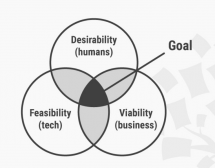Design Thinking: Getting Started with Empathy
This article describes empathy as the first step in human-centered development. In a general sense, empathy is our ability to see the world through other people’s eyes, to see what they see, feel what they feel, and experience things as they do.
In design thinking, empathy is, as explained in IDEO’s Human-Centred Design Toolkit, a “deep understanding of the problems and realities of the people you are designing for”. It involves learning about the difficulties people face, as well as uncovering their latent needs and desires in order to explain their behaviours. To do so, one needs to have an understanding of the people’s environment, as well as their roles in and interactions with their environment.
Empathy helps one gain a deeper appreciation and understanding of people’s emotional and physical needs, and the way they see, understand, and interact with the world around them. It also helps in understanding how all of this has an impact on their lives generally, and specifically within the contexts being investigated. Unlike traditional marketing research, empathic research is not concerned with facts about people (such as their weight or the amount of food they eat), but more about their motivations and thoughts (for instance, why they prefer to sit at home watching TV as opposed to going out for a jog). It’s inherently subjective, since there is a fair amount of interpretation involved in finding out what people mean rather than what they say.
Last modified: March 25, 2019
Language: English

